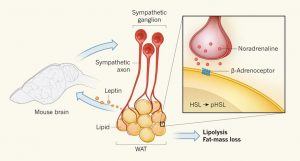There are two main types of hormones that are attached to body fat which affect our metabolism: estrogen and leptin. Both hormones are responsible for the body accumulating fat, mainly after puberty. The body relies on this mechanism as a good source of energy when it needs it most (during starvation, pregnancy, etc.)
Most men have a small amount of estrogen and women have a similar amount of androgen. For men and women, estrogen is deposited deep in the belly fat (subcutaneous and visceral fat). For postmenopausal women and for middle-aged men, these estrogen deposits make it difficult to shed belly fat. Of course, vigorous exercise, healthy eating, abdominal exercises would help reduce belly fat. But, it takes a lot of determination and persistence. For most people, it is a disappointment.
We are showing that using radio frequency (RF) waves to melt subcutaneous fat, a novel way to effectively melt subcutaneous fat, namely truSculpt iD, has cosmetic as well as metabolic benefits. Leptin and estrogen are released by targeting subcutaneous fat. We are showing that by reducing subcutaneous estrogen, men can increase their vigor because testosterone is no longer inhibited, and get a feeling of well being, energy, as well as a reduction in fat.
In women, who have difficult time reducing belly fat, inner thigh, hip fat, this method method will help them release the deposited estrogen, and thereby reduce fat accumulation.

Leptin is a hormone produced by subcutaneous fat cells. The amount of leptin in obese individuals is unusually high. Leptin has a feedback mechanism to the brain (the hypothalamus) in regulating fat intake. In starvation diet and periodic fasting, leptin levels fall, signaling in the hypothalamus to stimulate appetite for fat intake.
By gradually reducing leptin through RF fat (melting done by truSculpt iD), we are showing that we can prevent this mechanism of increasing appetite at the same time help shift the liver into lipolysis mode.
Cholesterol medication like statins are designed to block the liver’s production of cholesterol, not stimulate lipolysis. We are predicting that by inducing the liver to go into “lipolysis mode,” breaking down fat, it will help reduce stored fat (subcutaneous as well as visceral, and reduce fatty liver). We have observed initial rise in total cholesterol which is an indication of the melted fat being absorbed and metabolized. This should altogether have a beneficial effect on the body’s total cholesterol count.
In conclusion, we are seeing that patients who undergo RF lipolysis (truSculpt fat melting) have numerous metabolic benefits besides the obvious cosmetic outcomes. It promotes the release of estrogen and leptin from subcutaneous fat, and lets the liver start going into “lipolysis mode” — fat degradation. It helps men increase their vigor by reducing stored subcutaneous estrogen. In women, the treatment helps release leptin and estrogen and helps them achieve their targeted reduction in stored fat in subcutaneous areas. Finally, the procedure can reduce leptin in a gradual way, as to not increase appetite.

